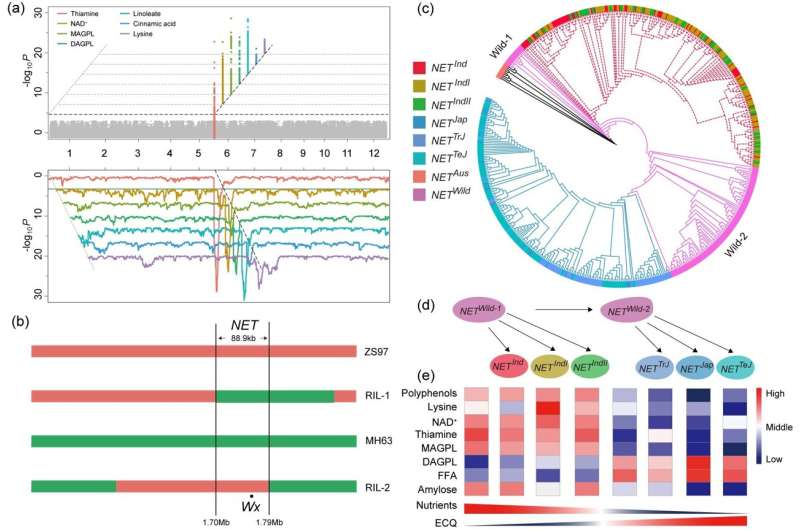(a) Locations of mGWAS and mQTL for thiamine, NAD+, MAGPL, DAGPL, linoleate, cinnamic acid, and lysine. (b) An 88.9 kb genomic region (NET) overlapped by two RILs. (c) Phylogenetic relationships of the NET regions from the GWAS panel and wild rice. (d, e) The domestication route of the NET region, and the content of nutrient metabolites and amylose in each subgroup. Credit: Science China Press
Rice (Oryza sativa L.) is one of the most important crops worldwide, providing much of the calorific needs for half of the global population. Economic development and rising living standards have led to the demand for rice gradually shifting from satisfying the need to "be full" to satisfying the need to "eat well," and combining flavor with nutrition is essential for the latter. Much research has focused on improving the eating and cooking quality (ECQ) of rice to meet the demand for "tasty." However, effort to improve comprehensive nutrition in rice remains fragmented.
In a new study published in Science Bulletin, taking advantage of metabolome genome-wide association study (mGWAS) and metabolome quantitative trait loci (mQTL) analyses, researchers localized and characterized a rice grain nutrients locus, NET (nutrition, eating, taste). This locus controls both rice ECQ and multiple nutrients accumulation, including vitamins, lipids, amino acids and polyphenols. Furthermore, the regulatory mechanism of NET was elucidated based on bioinformatics analysis and molecular biology experiments.
The domestication routes results showed that the NET regions in indica and japonica originated from two different wild rice groups, Wild-1 and Wild-2, respectively. The NET of indica may be evolved from Wild-1, which retains high nutrition but poor flavor due to a high amylose ratio and low content of fatty acids.
The Wild-2 NET exhibited by japonica improves its satiety potential and flavor quality by reducing the proportion of amylose and increasing the fatty acid content, but this process comes at the expense of multiple nutrients. This indicates that the flavor quality and nutrition quality have not been effectively balanced in the rice breeding process.
Therefore, in order to meet people's goal of "eating well," it is necessary to take into account the changes of nutrients in the breeding process for taste to achieve the best of both worlds, and the NET locus appears to be one of the most important genetic loci to achieve this goal.
In summary, this study clarifies the genetic mechanism of changes in nutrient metabolites during rice domestication, and provides a breeding scheme for obtaining ideal flavorful and nutritional varieties.
More information: Yufei Li et al, The NET locus determines the food taste, cooking and nutrition quality of rice, Science Bulletin (2022). DOI: 10.1016/j.scib.2022.09.023
Provided by Science China Press
























